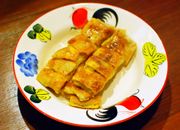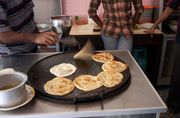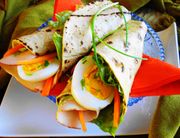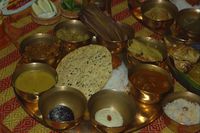Roti
 Indian flat roti, also known as chapati |
|
| Origin | |
|---|---|
| Place of origin | Indian subcontinent[1] |
| Region or state | South Asia |
| Dish details | |
| Main ingredient(s) | Atta flour |
| Variations | Chapati, Makki di roti, Tandoori roti, Roti canai |
Roti (Hindi: रोटी; Bengali: রুটি; Marathi: पोळी; Kannada: ರೊಟ್ಟಿ; Urdu: روٹی; Dhivehi: ރޮށި; Punjabi: ਰੋਟੀ; Tamil: ரொட்டி;Thai: โรตี), in general, is defined as an unleavened flatbread made from atta flour in the Hindi, Urdu, Punjabi, Assamese, Indonesian, Malay, Bengali, Thai, Marathi and Somali languages. It is also known as rotli in Gujarati, "Maani" in Sindhi and phulka in Punjabi and Saraiki. Its defining characteristic is that it is unleavened. The ubiquitous Indian bread naan, in contrast, is a yeast-leavened bread.
Roti and its thinner variant, known as chapati, are an integral part of Indian cuisine.[2] It is particularly popular in northern India, Central India and Western India.[3] In the Indian state of Maharashtra and some parts of Gujarat, poli and bhakri denote unleavened Indian breads.
Contents |
Etymology
The word roti is derived from the Sanskrit word रोटिका (roṭikā), meaning "bread."[4]
India, Bangladesh and Pakistan
There are many different variations of flat breads found in many cultures across the globe, from Indian subcontinent to the Americas. The traditional flat bread originating from the Indian subcontinent is commonly known as roti, pronounced "rho - tee". It is normally eaten with curries or cooked vegetables; it can be called a carrier for curries or cooked vegetables. It is made most often from wheat flour, cooked on a flat or slightly concave iron griddle called a tawa. It is similar to the tortilla in appearance. Like breads around the world, roti is a staple accompaniment to other foods, and maybe spread with ghee (clarified butter). Roti can also be known as bangali.
 Plain roti paratha |
 Indian thali with chapati |
 Tandoori roti with Pakistani dishes |
 A chef preparing rumali roti in India |
Blended roti
Whole wheat can be blended with other flours to make highly nutritious roti. Below is the ratio in which one of the best recommended nutritious blended flours is mixed:
| Flour | Percentage |
|---|---|
| Whole wheat flour | 60 |
| Barley flour | 20 |
| De-fatted soybean flour | 7 |
| Black chickpea flour | 13 |
Sri Lanka
In Sri Lanka probably the most popular type of roti is pol roti (coconut roti), made of wheat flour, kurakkan flour or a mixture of both and scraped coconut. Sometimes chopped green chillies and onion are added to the mixture before cooking. These are usually thicker and harder than other roti types. They are usually eaten with curries, or some types of sambol or lunu miris and considered a main meal rather than a supplement.
Indonesia, Malaysia and Thailand


In Indonesia, Malaysia, and Somalia, the term encompasses all forms of bread including western-style bread as well as the traditional Punjabi breads.
In Thailand, "roti" refers to the maida paratha—known in Malaysia as roti canai and in Singapore as roti prata—which is sometimes drizzled with condensed milk, rolled up, and eaten as a hot snack, or fried with egg as a larger dish.
West Indies
Roti also features prominently in the diet of many Caribbean countries, especially Trinidad and Tobago, Guyana and Jamaica. West Indian roti are primarily made from wheat flour, baking powder, salt, and water and cooked on a tava. Certain rotis are also made with butter. There are several types of roti made in the West Indies.
| Food | Description |
|---|---|
| Sada Roti | This is a plain roti, made of white flour. Because it is the simplest roti to make, it is the most commonly consumed roti in Trinidad. It is a popular breakfast option in Trinidad, in combination with tomato choka, baigan choka (eggplant), and other vegetable dishes. |
| Paratha Roti | A roti made with butter, usually ghee (Clarified Butter) but any butter can be used with it, the roti is put onto the tawa and butter is spread out onto it, partha eventually turns brown, and has more taste than the plain traditional roti, paratha is traditionally eaten with fried eggs and/or a cup of tea. A tawa is (a round, flat metal griddle used in Indian cooking). Ghee is rubbed on both sides, then it is cooked on the tawa. This gives the roti a crisp outside. When it almost finished cooking, the cook begins to beat the roti while it is on the tawa, causing it to crumble. It is also called 'Buss-Up-Shut' in Trinidad. |
| Dosti Roti | A roti where two layers are rolled out together and cooked on the tava. It is also rubbed with oil while cooking. It is called dosti roti because the word dosti means friendship in Hindi. This type of roti is eaten in Guyana with a special halva when a child is born. |
| Dhalpuri[5] | A roti with a stuffing of ground yellow split peas, cumin (geera), garlic, and pepper. The split peas are boiled until they are al dente and then ground in a mill. The cumin is toasted until black and also ground. The stuffing is pushed into the roti dough, and sealed. When rolled flat, the filling is distributed within the roti. It is cooked on the tava and rubbed with oil for ease of cooking. This is the most popular roti. |
| Wrap Roti | A popular sandwich made by folding a curry stew inside of a Dhalpuri roti skin. Curry stew normally contains potatoes and a meat of some sort like chicken, goat, beef or shrimp. |
| Piper Roti | A wrap roti that usually contains only potatoes and gravy, and scrap meat. Piper roti got its name by being a cheaper alternative to purchasing a regular roti. the term "piper" is the local slang used to describe a drug addict; most of his money is spent on drugs and the little he has remaining will purchase food. For example a chicken roti will be $20.00TT where as a piper roti will be $8.00TT |
| Aloopuri | A roti similar to a Dhalpuri but with aloo (potato) substituted for the dhal. The aloo is boiled, milled and spices and seasonings are added before being sealed in the dough. This aloo filling is also used when making aloo pie or aloo choka. |
| Fry Bake | Similar to making a Sada roti. After the dough is rolled, instead of cooking it on the tava as you would with the sada roti, the rolled dough is cut into quarters and each piece is deep fried until golden. The dough usually rises in the oil so the finished product can be cut open and filled with various fillings before it's consumed. Fry Bake by definition can be considered a "puri", as compared to a "Dhal puri" which in reality is a type of roti. |
| Bake | Made with butter, coconut milk and grated coconut meat. Sometimes referred to as "Creole Bake". The finished dough is placed in a round cake pan and baked until done. |
Guyana
Depending on where Indians settled in Guyana, foods can be different. In some parts of Guyana, Dosti Roti is made. Indo-Guyanese food as a whole can be different from their Trinidadian brothers, including the names of many items.
- A small amount of fat is placed in each piece of dough before it is rolled out to make the roti softer. Usually Vegetable oil is used, but butter, or margarine can also be used. Ghee is not used in everyday Guyanese cooking, and is only used by the Hindus on religious occasions. The Roti is usually clapped by hand or beaten a bit, hot off the tava, so it softens but does not break.
- A good roti in Guyana is one that is very soft, with layers (almost like pastry layers if possible), which remains whole.
- Depending what is placed in the dough before it is rolled out, that is the type of roti one gets. Various types include Dhalpuri, potato roti, and even sugar(to keep the kids busy, while the mother finishes cooking).
- Among the Indo-Guyanese, a rolled out dough that is deep fried in ghee is called a puri, and is only made for Hindu religious gatherings. Therefore a Dalpuri is not really a puri, as a puri and a roti are two different things.
- Another item prepared like roti is bake or bakes or floats. Dough is rolled out and cut into shapes or rolled into small rounds. Guyanese bakes or floats are fried, but bakes from other parts of the West Indies can can be baked in an oven. They are sometimes called frybake. Bake are usually paired with a fryup for breakfast or dinner, or with stewed saltfish. Bakes is also made in other parts of the West Indies including Trinidad, Barbados and St. Vincent.
Other dishes

.jpg)
The word 'roti' in the West Indies may also refer to a dish of stewed or curried ingredients wrapped in a 'roti skin'. In Trinidad and Tobago various rotis are served. Popular variations include chicken, conch, beef and vegetable. Shrimp and goat are available. The term is used locally in cities with large West Indian populations, such as Brooklyn, Toronto and Montreal. In such locales the dish has also become popular among non-West Indians.
Roti, pronounced "Rooti" in Cape Town, is also a staple food source amongst many of the indian, asian and cape coloured communities living in South Africa and is either eaten as a flat bread or a wrap with locally made curries.
While common variations may include chicken, beef, or cabbage and carrot, one of the more authentic alternatives (goat) is known as Groti.
In Suriname roti refers mainly to roti dahlpuri or roti aloopuri. It is most often eaten with chicken curry. Roti can also refer to a dish of stuffed and spiced roti wraps. Due to mass emigration of Surinam Hindustani in the 1970s, roti became a popular take-out dish in the Netherlands. It usually includes chicken curry, potatoes, boiled eggs and various vegetables, most notably the kousenband or yardlong bean. Another variation includes shrimp and aubergine. It is custom to eat the dish by hand.
See also
- Chapati
- Puri
- Naan
- Paratha
- Kulcha
- Bhatura
- Luchi
- Roti canai
- Roti (film)
- Kottu Roti
- Wrap roti
References
- ↑ The Cape Malay Cookbook - By Faldela Williams, Cornel de Kock
- ↑ India - By Michael Dahl
- ↑ The Food of India - By Priya Wickramasinghe, Carol Selva Rajah, Jason Lowe, Alan Benson
- ↑ "Rotika (रोटिका)". Spoken Sanskrit. http://spokensanskrit.de/index.php?script=HK&tinput=%E0%A4%B0%E0%A5%8B%E0%A4%9F%E0%A4%BF%E0%A4%95%E0%A4%BE+&country_ID=&trans=Translate&direction=AU. Retrieved 2007–03–25.
- ↑ Dhal Puri Recipe - NomadicGourmet.com
|
||||||||||||||||||||||
